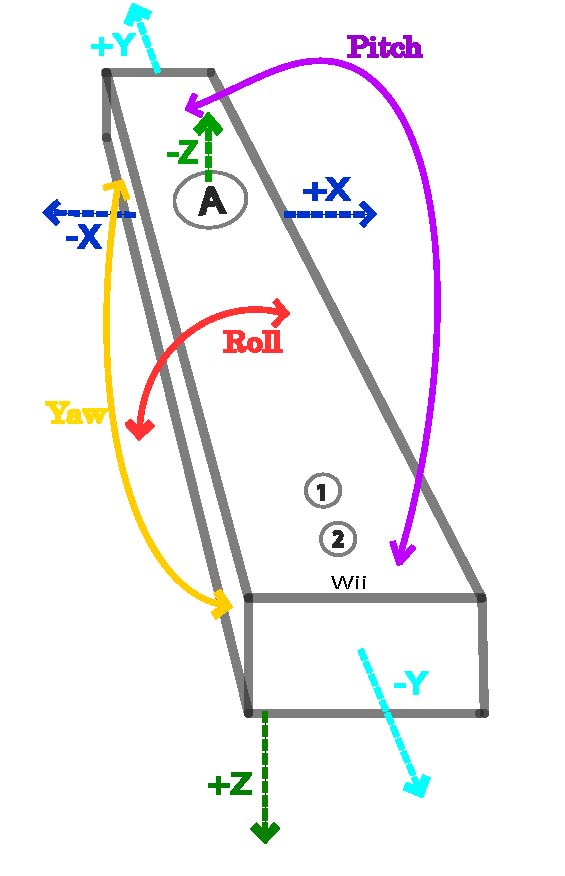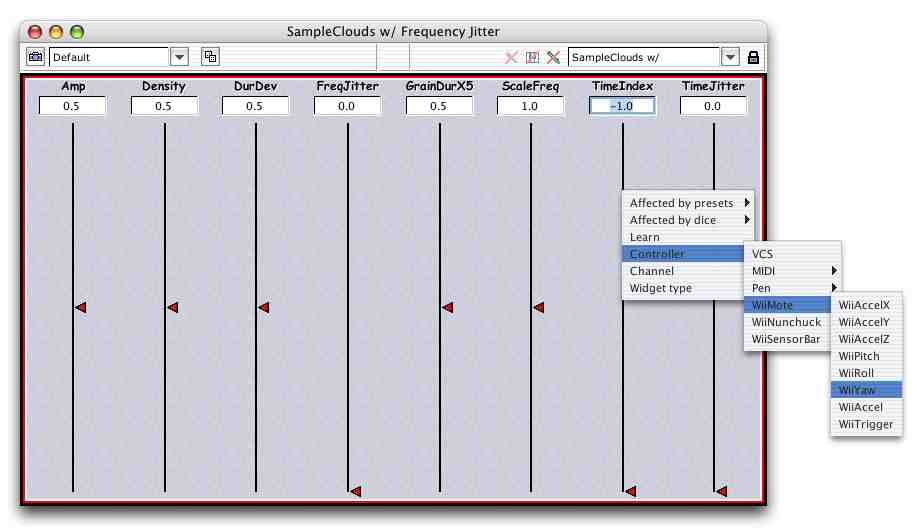| kyma•tweaky . Learn . UsingTheNintendoWiimoteWithKyma |
 Now that you've studied the picture, here are the thousand words anyway. Imagine you're an astronaut pilot executing maneuvers on the Space Shuttle.
NASA asks you to adjust the Pitch. Imagine a wire running through the shuttle from the tip of the left wing through to the tip of the right wing; then imagine rotating around that axis, with the nose and the tail exchanging positions as you pitch forward.
Now that you've studied the picture, here are the thousand words anyway. Imagine you're an astronaut pilot executing maneuvers on the Space Shuttle.
NASA asks you to adjust the Pitch. Imagine a wire running through the shuttle from the tip of the left wing through to the tip of the right wing; then imagine rotating around that axis, with the nose and the tail exchanging positions as you pitch forward.
 Next, NASA asks you to adjust the Yaw. Now you can imagine a pole from the floor of the shuttle up to the ceiling; then imagine the shuttle spinning around that pole like a top, so the nose moves to where the right wing used to be and the tail moves to where the left wing used to be and so on.
Next, NASA asks you to adjust the Yaw. Now you can imagine a pole from the floor of the shuttle up to the ceiling; then imagine the shuttle spinning around that pole like a top, so the nose moves to where the right wing used to be and the tail moves to where the left wing used to be and so on.
 And finally, NASA asks you to adjust the roll: Imagine a wire running through the Shuttle from the nose to its tail; then imagine rotation around that axis, so the left and right wings alternate positions (like when a van gets into a side collision and rolls over and over).
And finally, NASA asks you to adjust the roll: Imagine a wire running through the Shuttle from the nose to its tail; then imagine rotation around that axis, so the left and right wings alternate positions (like when a van gets into a side collision and rolls over and over).
 When you are holding the Wiimote just imagine that the Wiimote is a toy space shuttle and you will have a perfect understanding of the Pitch, Yaw, and Roll (without the motion-sickness associated with an actual ride in the Space Shuttle).
When you are holding the Wiimote just imagine that the Wiimote is a toy space shuttle and you will have a perfect understanding of the Pitch, Yaw, and Roll (without the motion-sickness associated with an actual ride in the Space Shuttle).
 You can also use the following hot values directly or as part of a CapyTalk expressions in a parameter field of a Sound. (The range of each hot value as assigned in the default global map is listed in parentheses following the hot value's name):
You can also use the following hot values directly or as part of a CapyTalk expressions in a parameter field of a Sound. (The range of each hot value as assigned in the default global map is listed in parentheses following the hot value's name):
| !WiiAccelX | (-1,1) |
| !WiiAccelY | (-1,1) |
| !WiiAccelZ | (-1,1) |
| !WiiPitch | (-1,1) |
| !WiiRoll | (-1,1) |
| !WiiYaw | (-1,1) |
| !WiiAccel | (0,1) |
| !WiiBarX | (0,1) |
| !WiiBarY | (0,1) |
| !WiiTrigger | (0,1 grid: 1) |
| !WiiButtonB | (0,1 grid: 1) |
| !NunAccelX | (-1,1) |
| !NunAccelY | (-1,1) |
| !NunAccelZ | (-1,1) |
| !NunPitch | (-1,1) |
| !NunRoll | (-1,1) |
| !NunYaw | (-1,1) |
| !NunAccel | (0,1) |
| !NunJoyX | (-1,1) |
| !NunJoyY | (-1,1) |
| !NunTriggerC | (0,1 grid: 1) |
| !NunTriggerZ | (0,1 grid: 1) |
----- Revision r1.14 - 12 Jan 2008 - 18:13 GMT - CarlaScaletti
|